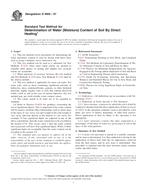We need your consent to use the individual data so that you can see information about your interests, among other things. Click "OK" to give your consent.
ASTM D4959-07
Standard Test Method for Determination of Water (Moisture) Content of Soil By Direct Heating
STANDARD published on 1.2.2007
The information about the standard:
Designation standards: ASTM D4959-07
Note: WITHDRAWN
Publication date standards: 1.2.2007
SKU: NS-29295
The number of pages: 6
Approximate weight : 18 g (0.04 lbs)
Country: American technical standard
Category: Technical standards ASTM
The category - similar standards:
Annotation of standard text ASTM D4959-07 :
Keywords:
acceptance tests, compaction control, density, direct heating, laboratory moisture tests, moisture content, moisture control, quality control, rapid method, soil moisture, test procedure, ICS Number Code 13.080.40 (Hydrological properties of soil)
Additional information
| 1. Scope | ||||||||||||
|
1.1 This test method covers procedures for determining the water (moisture) content of soils by drying with direct heat, such as using a hotplate, stove, blowtorch, etc. 1.2 This test method can be used as a substitute for Test Methods D 2216 when more rapid results are desired to expedite other phases of testing and slightly less accurate results are acceptable. 1.3 When questions of accuracy between this test method and Test Methods D 2216 arise, Test Methods D 2216 shall be the referee method. 1.4 This test method is applicable for most soil types. For some soils, such as those containing significant amounts of halloysite, mica, montmorillonite, gypsum, or other hydrated materials, highly organic soils or soils that contain dissolved solids, (such as salt in the case of marine deposits), this test method may not yield reliable water content values. 1.5 The values stated in SI units are to be regarded as standard. 1.6 Refer to Practice D 6026 for guidance concerning the use of significant figures. This is important if the water content will be used to calculate other relationships such as moist mass to dry mass or vice versa, wet unit weight to dry unit weight or vice versa, and total density to dry density or vice versa. For example, if four significant digits are required in any of the above calculations, then the water content has to be recorded to the nearest 0.1%. This occurs since 1 plus the water content (not in percent) will have four significant digits, While, if three significant digits are acceptable, then the water content can be recorded to the nearest 1% 1.7 This standard does not purport to address all of the safety concerns, if any, associated with its use. It is the responsibility of the user of this standard to establish appropriate safety and health practices and determine the applicability of regulatory limitations prior to use. |
||||||||||||
| 2. Referenced Documents | ||||||||||||
|
We recommend:
Updating of laws
Do you want to be sure about the validity of used regulations?
We offer you a solution so that you could use valid and updated legislative regulations.
Would you like to get more information? Look at this page.




 Cookies
Cookies
